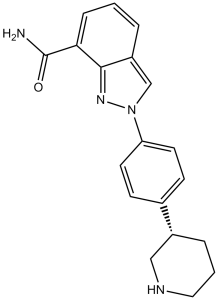Niraparib (MK-4827)
This product is for research use only, not for human use. We do not sell to patients.

For small sizes, please check our retail website as below: www.invivochem.com
| Size | Price | Stock |
|---|---|---|
| 250mg | $365 | In Stock |
| 500mg | $650 | In Stock |
| 1g | $975 | In Stock |
Cat #: V2570 CAS #: 1038915-60-4 Purity ≥ 98%
Description: Niraparib (formerly known as MK4827; MK-4827; Zejula) is a potent, orally bioavailable and selective inhibitor of PARP1/2 with anticancer activity.
Top Publications Citing Invivochem Products
Publications Citing InvivoChem Products
Product Promise

- Physicochemical and Storage Information
- Protocol
- Related Biological Data
- Stock Solution Preparation
- Quality Control Documentation
| Molecular Weight (MW) | 320.39 |
|---|---|
| Molecular Formula | C19H20N4O |
| CAS No. | 1038915-60-4 |
| Storage | -20℃ for 3 years in powder formr |
| -80℃ for 2 years in solvent | |
| Solubility In Vitro | DMSO: 64 mg/mL (199.8 mM)r |
| Water: <1 mg/mLr | |
| Ethanol: 64 mg/mL (199.8 mM) | |
| Synonyms | MK-4827; MK 4827; Niraparib free base; Zejula; MK4827; Chemical Name: (S)-2-(4-(piperidin-3-yl)phenyl)-2H-indazole-7-carboxamide |
| Protocol | In Vitro | Niraparib (MK-4827) inhibits PARP activity with EC50=4 nM and EC90=45 nM in a whole cell assay. MK-4827 inhibits proliferation of cancer cells with mutant BRCA-1 and BRCA-2 with CC50 in the 10-100 nM range. MK-4827 displays excellent PARP 1 and 2 inhibition with IC50=3.8 and 2.1 nM, respectively, and in a whole cell assay |
|---|---|---|
| In Vivo | Niraparib (MK-4827) is well tolerated and demonstrates efficacy as a single agent in a xenograft model of BRCA-1 deficient cancer. Niraparib (MK-4827) is well tolerated in vivo and demonstrates efficacy as a single agent in a xenograft model of BRCA-1 deficient cancer. Niraparib (MK-4827) is characterized by acceptable pharmacokinetics in rats with plasma clearance of 28 (mL/min)/kg, very high volume of distribution (Vdss=6.9 L/kg), long terminal half-life (t1/2=3.4 h), and excellent bioavailability, F=65% |
These protocols are for reference only. InvivoChem does not
independently validate these methods.
| Solvent volume to be added | Mass (the weight of a compound) | |||
|---|---|---|---|---|
| Mother liquor concentration | 1mg | 5mg | 10mg | 20mg |
| 1mM | 3.1212 mL | 15.6060 mL | 31.2120 mL | 62.4239 mL |
| 5mM | 0.6242 mL | 3.1212 mL | 6.2424 mL | 12.4848 mL |
| 10mM | 0.3121 mL | 1.5606 mL | 3.1212 mL | 6.2424 mL |
| 20mM | 0.1561 mL | 0.7803 mL | 1.5606 mL | 3.1212 mL |
The molarity calculator equation
Mass(g) = Concentration(mol/L) × Volume(L) × Molecular Weight(g/mol)
Mass
=
Concentration
×
Volume
×
Molecular Weight*
The dilution calculator equation
Concentration(start)
×
Volume(start)
=
Concentration(final)
×
Volume(final)
This equation is commonly abbreviated as: C1 V1 = C2 V2
Concentration(start)
C1
×
Volume(start)
V1
=
Concentration(final)
C2
×
Volume(final)
V2
Step One: Enter information below
Dosage mg/kg
Average weight of animals g
Dosing volume per animal µL
Number of animals
Step Two: Enter the in vivo formulation
%DMSO
+
%
+
%Tween 80
+
%ddH2O
Calculation Results:
Working concentration:
mg/ml;
Method for preparing DMSO master liquid:
mg
drug pre-dissolved in
µL
DMSO(Master liquid concentration
mg/mL)
,Please contact us first if the concentration exceeds the DMSO solubility of the batch of drug.
Method for preparing in vivo formulation:
Take
µL
DMSO master liquid, next add
µL
PEG300, mix and clarify, next add
µL
Tween 80,mix and clarify, next add
µL
ddH2O,mix and clarify.
Note:
- (1) Please be sure that the solution is clear before the addition of next solvent. Dissolution methods like vortex, ultrasound or warming and heat may be used to aid dissolving.
- (2) Be sure to add the solvent(s) in order.




































